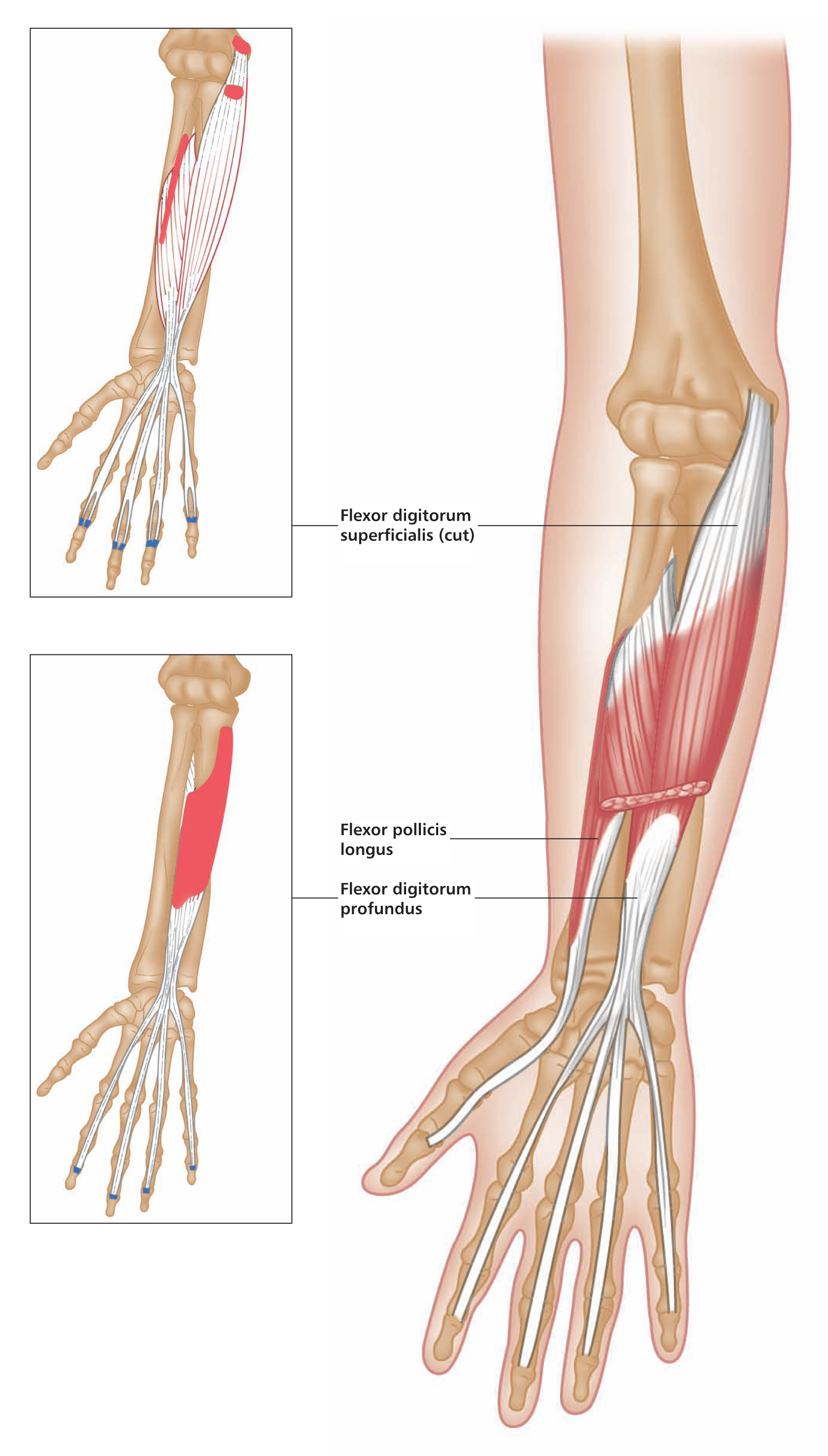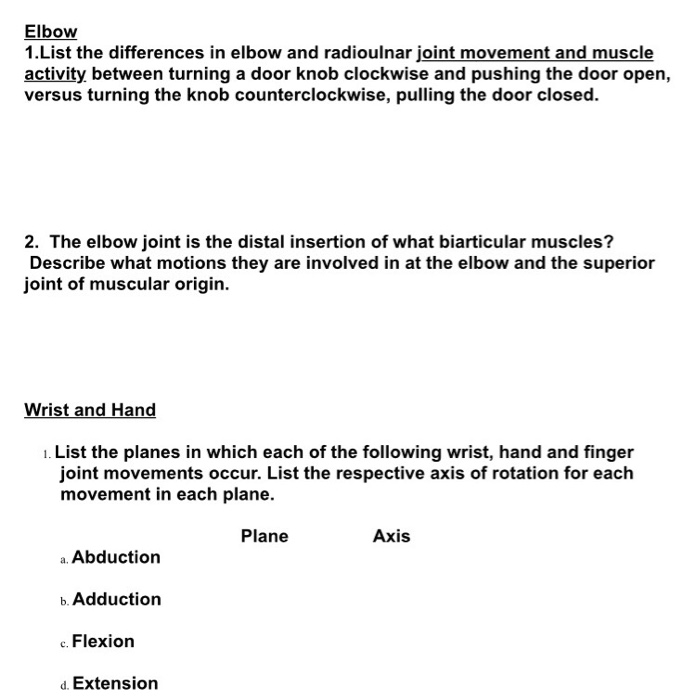Describe the Joints and Movements Involved in Turning a Doorknob
Crossing your legs while sitting. The function of the biceps brachii is to flex the elbow and supinate the forearm and the other function is to abduction and flexion of the shoulder joint.

Muscles Of The Forearm And Hand Musculoskeletal Key
Formed by the femur and the os coxae.

. Special movements 10. The only thing that a muscle can do is contract shorten acting on a joint. Short-Answer Questions Describe the joints and movements involved in the following tasks.
The next part of the movement is followed by the triceps brachii and anconeus to extend the elbow joint to push the door open. Which joint movement involves moving the leg towards the midline. What movement occurs at the elbow joint when you turn a door knob counterclockwise and pull the door open.
Turning the door knob counterclockwise and pulling the door open. One place where we routinely use our elbow and forearm is the seemingly simple act of turning a doorknob. Four categories of joint movement.
Turning the door knob clockwise and pushing the door open. This is one of the most common types of door locks. Turning door knob anticlockwise wrist joint Supination.
We would likely need to flex our elbow to bring our hand up to the doorknob and then we would do supination of the forearm if we were turning the doorknob to the right. What movement occurs at the radioulnar joint when you turn a door knob counterclockwise and pull the door open. Radioulnar joints The movements of pronation and supination occur at synovial pivot joints found at the proximal and distal ends of the radius and ulna.
The elbow joint is the distal insertion of which biarticular muscles. Abduction at the hip joint ranged from 19 degrees to 57 degrees with a mean of 39 degrees. Describe the joints and movements involved in a.
Throwing a ball. What is the differens between a door case and a door portal. Involves supination which is achieved by concentric activity in the.
Turning a doorknob. Walking hip knee ankle joints-dorsiflexion plantar flexion flexion of the knee and hip extension of the knee and hip b. Which joint movement involves swinging the arm around in a circle.
Crossing your legs while sitting hip joint-extension. Throwing a ball а 3. Which movement involves moving away from the midline.
Extension is otherwise known as straightening. Turning a doorknob wrist and elbow joints-pronation supination d. Involves pronation which is accomplished with concentric.
Flexion is commonly known as bending. Throwing a ball shoulder elbow wrist and phalangeal joints-flexion extension gliding c. Shaking your head no 6.
Movement of the forearm so that the palm faces downwards. Tumbler door locks work with the key being put in the lock and tumbler turning. Refers to movement where the angle between two bones decreases.
The two biarticular muscles that are used for the insertion of the elbow are the triceps brachii muscles and the biceps brachii. The fingers and thumb exert pressure on the tap while the forearm movement provides the power to turn it. Turn a tap or a round door-knob.
The functions of the triceps brachii muscles is to extend the elbow and also adduction and. See the answer See the answer done loading. A muscle can remain contracted as those two points separate controlling and slowing the release.
Grasp the doorknob the distal interphalangeal joint proximal interphalangeal joint metacarpal joint and radiocarpal joints are all involved in the grasp and turning of the doorknob. Some of the key joint actions that you should know are detailed in the following tables. Which type of joint allows twisting and turning side to side.
How muscles work comes down to their movement and the planes which this movement happens. Describe what motions each is involved. Refers to movement where the angle between two bones increases.
Supinator brachioradialis and biceps brachii followed by the triceps brachii and anconeus to extend the elbow. And is used to describe the swelling of joints due to osteoarthritis. Flexion at the hip joint ranged from 82 degrees to 100 degrees with a mean of 91 degrees.
By shortening its length a muscle can bring two points closer together. - Using the right hand to turning the door knob clockwise and pushing the door open requires supination which is achieved by concentric activity in the supinator brachioradialis and biceps brachii followed by the triceps brachii and anconeus to extend the elbow. What 2 layers are serous membranes composed of.
A ball and socket joint allows twisting and turning side to It humans. Like turning a door knob. Desecribe the joints and movements involved in.
Turning the head from side to side as when you shake your head no. Up to 24 cash back 3. Analyze and list the differences in elbow and radioulnar joint muscle activity between turning a door knob clockwise and pushing the door open and turning the knob counterclockwise and pulling the door open.
The other word which is widely used instead of doorknob is latch. Turning a doorknob 4. The external rotation ranged from 42 degrees to 58 degrees with a mean of 49 degrees.
Anatomy and Physiology questions and answers. Shaking you head no. Hold your arm out and move in a circle.
Movement of the forearm so that the palm faces upwards. Describe the hip joint 2 1. Crossing your legs while sitting 5.

Solved Elbow 1 List The Differences In Elbow And Radioulnar Chegg Com

The Elbow And Forearm In Movement 3d Muscle Lab

Describe The Joints And Movements Involved In Turning A Doorknob Brainly Com
0 Response to "Describe the Joints and Movements Involved in Turning a Doorknob"
Post a Comment